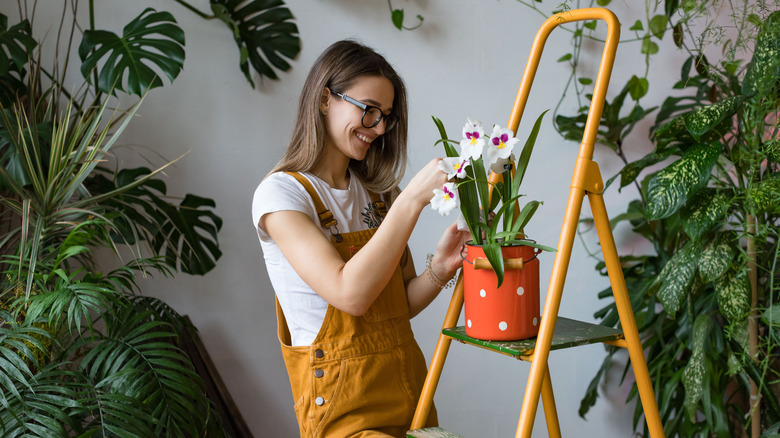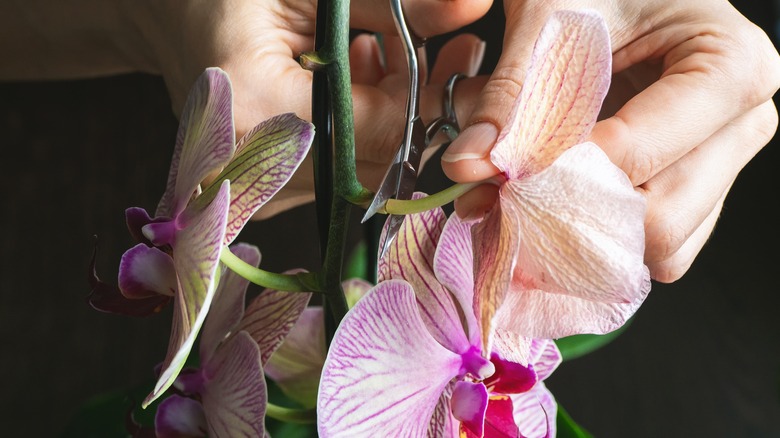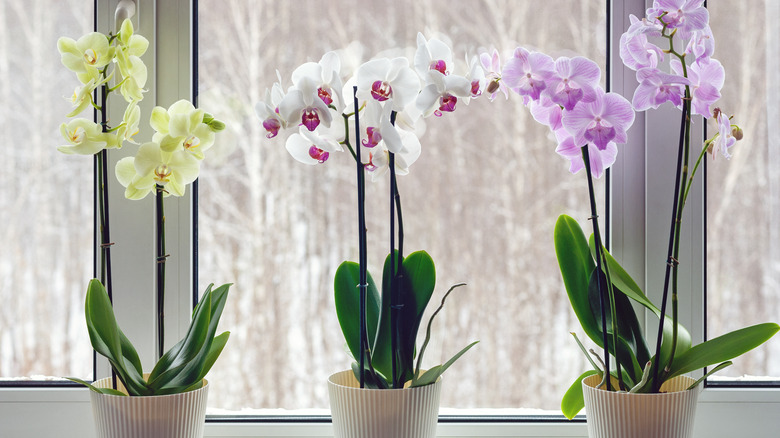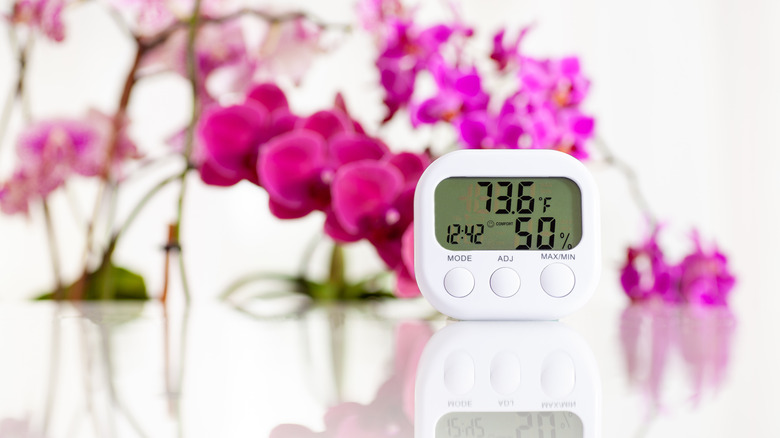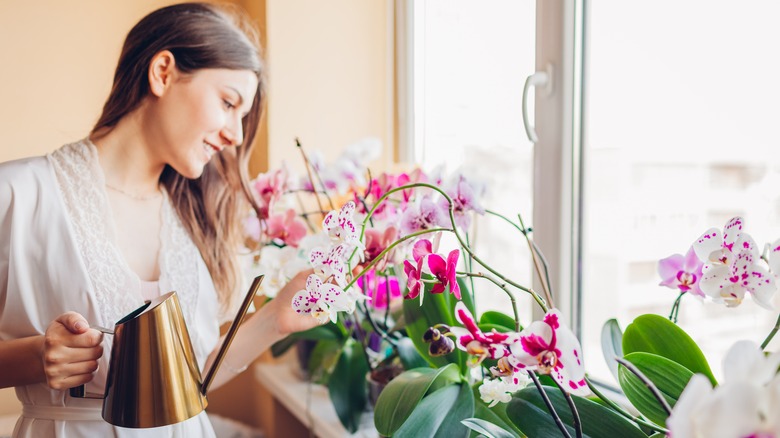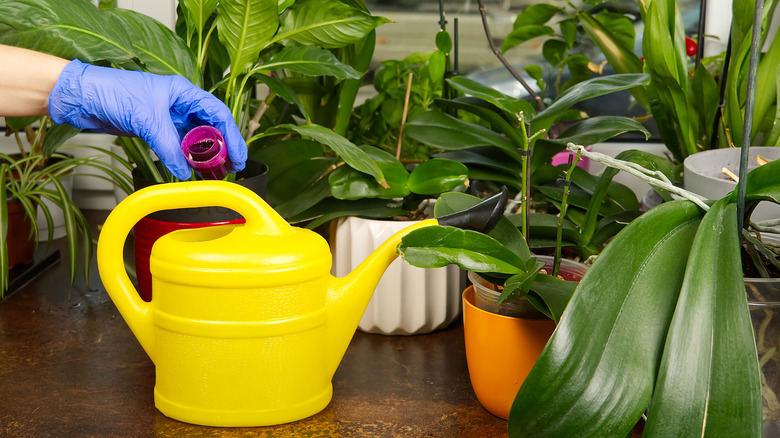How To Make Your Orchid Bloom Again
Orchids are beautiful plants with thick green leaves and many colorful flowers. Depending on the species of orchid, these flowers can be almost any combination of colors with intricate patterns. Luckily there are over 30,000 different species of orchids to choose from, according to the Oregon Orchid Society. They are known for being tropical plants, growing mainly in South America and Southeast Asia, but they can be found worldwide, excluding Antarctica.
The most common type of orchid is the Phalaenopsis or moth orchid. This species is the one you see while walking in the grocery store or at any chain garden center. With the proper knowledge, they can be easy to keep alive. However, many people assume they are dying when they drop their flowers and toss them away. Giving your plant the chance to thrive will provide you with gorgeous blooms for 12 or more weeks every year (via Longwood Gardens). For this to happen, you will have to care for them throughout the year and slightly change their environment when it's time to grow flowers.
Trim the flower spikes
The first step when preparing your orchids to rebloom is trimming the flower spikes. You want to do this to promote new growth, according to Orchidbliss. Sanitizing your shears is very important because if you don't, you risk spreading viruses from sick plants to healthy ones. The best way to do this is by soaking a cotton ball in some rubbing alcohol and wiping your shears.
If you have a moth orchid, the most common type sold in garden centers, all the flowers will rebloom from the same stalk. With this species, you want to cut the stem between the first set of nodes below the cluster of flowers. Other types of orchids bloom from multiple stalks. These need trimming at the base of the stem but be careful not to cut low enough that you hit the pseudobulbs or remove any leaves. However, if your moth orchid has brown stalks that are starting to die, you should also trim it at the base.
Follow their natural light cycle
Creating the perfect environment will help your orchid to produce more beautiful flowers. These plants have adapted to survive in low light, but for them to thrive and bloom, they need a lot of bright indirect sunshine. They need a schedule of 12 to 14 hours of light every day, according to Gardeners Supply Company. In the winter, they prefer 12 hours of sunlight, and in the summer, they should be getting 14 hours. Essentially, you need to mimic the environment an orchid would be in if they were outside in the sun.
The best place to put an orchid is in a south or east-facing window because they provide bright light. A west-facing window may burn your plant, while a north-facing is too dark. If your home doesn't have south or east-facing windows where you can place your orchid or the sun isn't out long enough, you can supplement the natural lighting with fluorescent grow bulbs. You should keep these at least 6 to 8 inches away from your plants, or it will burn them. You will know if your orchid is receiving enough light if its leaves are a medium to bright green. If they are dark green, it needs more sunlight.
Provide the correct temperature
Even the room temperature will affect if your orchids bloom again. Throughout the year, orchids prefer when their nighttime temperature drops about 10 degrees from what it was during the day. However, the climate needs to drop about 20 degrees to promote blooms. Just Add Ice recommends keeping orchids at a daytime temperature between 65 and 80 degrees Fahrenheit and a nighttime climate of 60 to 70 degrees Fahrenheit. When prepping for new blooms, the evening temperature should be between 55 and 65 degrees Fahrenheit.
To achieve this, you can either have a temperature-controlled room where you keep your plants or move your orchids at the end of the day. Changing their location to a colder room every night will give them the difference in temperature that they need. Although, you need to be careful not to create a freezing climate by adding a draft. Opening windows and cranking AC units will shock your plant. The best time to start giving your orchids extra cold nights is about a month before you want them to bloom. You can also look for new shoots growing out of the soil that will tell you it's time to prepare to grow flowers.
Give water sparingly
Orchids can be a tricky plant to water. People often receive advice to give them ice cubes, but as tropical plants, their roots can't handle the cold water (via Ohio Tropics). They also need soil that holds moisture, like sphagnum moss, but keep in mind it can cause harm if it's too dense around the roots. Similar to many plants, orchid roots do not like sitting in a puddle of water. It will turn them mushy and create root rot. To keep your orchid thriving so it can bloom, you must find the middle ground between keeping the soil moist and not soaking wet.
Costa Farms recommends checking the soil every 7 to 10 days by sticking a finger into the pot and feeling if it is dry. There are two ways to water an orchid. You can use a watering can to pour water into the top of the pot or place the plant to soak in a bowl of water. The latter will help to prevent overwatering.
Fertilize regularly
Fertilizing your plants is vital because it supplies them with the nutrients they need to grow. It is necessary when attempting to rebloom orchids because it will give them what they need to develop new flower spikes and blooms. According to Plant Index, you will want to use two different fertilizers on your orchids. You should use an equal parts fertilizer to promote growth during the year. Then, when preparing your orchid to bloom, you should switch to a fertilizer that's high in phosphorus and low in nitrogen to support the growth of flowers.
The only time to not feed your plants is when they are in bloom. Otherwise, your plants should be on a schedule. To avoid over-fertilizing, you should dilute the fertilizer. Doing this makes it even easier because you will add it to your watering can. You can give your plants fertilizer about every two weeks or every other time you water them so you don't accidentally leave the roots sitting in a puddle.
